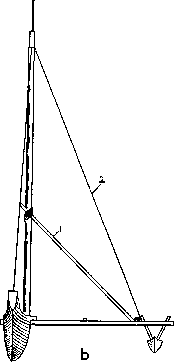 "Flying Proa" of the Marianas Islands
"Flying Proa" of the Marianas Islands
from
Canoes of Oceania
by A.C. Haddon and James Hornell
Bishop Museum Press,
Honolulu, Hawaii
Volume 1, p. 413..415 - An account by Baron George Anson in the year 1748.


Marianas/Ladrone Islands
The name "flying proa" given to these vessels is owing to the swiftness with which they sail... From some rude estimations made by our people of the velocity with which they crossed the horizon at a distance, while we lay at Tinian, I cannot help believing that with a brisk tradewind they will run near 20 miles an hour, which, though greatly short of what the Spaniards report of them, is yet a prodigious degree of swiftness...
| FIGURE 300.b) head view, outrigger to windward: 1, mast shore; 2, shroud. |
The construction of this proa is a direct contradiction to the practice of all the rest of mankind. For as the rest of the world make the head of their vessels different from the stern, but the two sides alike; the proa, on the contrary, has her head and stern exactly alike, but her two sides very different; the side intended to be always the lee side is flat, and the windward side is made rounding in the manner of other vessels.

| FIGURE 300.a) View from leeward with sail set: 1, one of two stays supporting mast, the other hidden behind sail; 2, matting sail; 3,4, running stays. |
And, to prevent her oversetting, which from her small breadth and the straight run of her leeward side would, without this precaution, infallibly happen, there is a frame laid out from her to windward, to the end of which is fastened a log, fashioned into the shape of a small boat and made hollow.

| FIGURE 300.c) plan: 1, proa; 2, "boat" at end of outrigger frame; 3,4, braces from the ends to steady frame; 5, thin plank placed to windward to prevent shipping of water, to serve as seat for native who bales, and sometimes as rest for goods transported; 6, part of middle outrigger boom on which mast is fixed; 7,8, horseshoe sockets, in one of which yard is lodged according to tack (after Anson, 1748). |
The weight of the frame is intended to balance
the proa, and the small boat is by its buoyancy (as it is always in the
water) to prevent her oversetting to windward; and the frame is usually
called an outrigger. The body of the proa (at least of that we took) is
made of two pieces joined endways and sewed together with bark, for there
is no iron used about her. She is about two inches thick at the bottom,
which at the gunwale is reduced to less than 1 inch. The dimensions of
each part will be better known from the uprights and views contained in
the annexed plate, which were drawn from an exact mensuration [fig. 300]... When [the proa] alters her tack, they bear away a little to bring her stern up to the wind, then by easing the halyard and raising the yard and carrying the heel of it along the lee side of the proa, they fix it in the opposite socket [fig. 300, c, 7-8], whilst the boom at the same time, by letting fly [one] sheet [fig. 300, a, 3-4] and haling the [other], shifts into a contrary situation to what it had before, and that which was the stern of the proa now becomes the head, and she is trimmed on the other tack. From the description of these vessels it is sufficiently
obvious how dexterously they are fitted for ranging this collection of
islands called the Ladrones. For as these islands bear nearly north and
south of each other and are all within the limits of the trade wind, the
proas, by sailing most excellently on a wind, and with either end foremost,
can run from one of these islands to the other and back again, only by
shifting the sail, without ever putting about; and by the flatness of their
lee side and their small
(original drawing
and here)
| Note: The "Flying Proa" or "Pacific proa" has a small
ama to windward, opposite that of the "Atlantic proa" with heavier hull to windward. See painting by Bruce Alderson of Dick Newick's 1968 Cheers |
Other Proa Pages